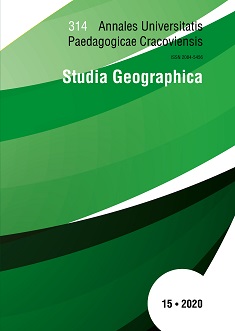Demographic problems of towns of the Małopolska voivodeship
DOI:
https://doi.org/10.24917/20845456.15.13Keywords:
demography, Małopolska voivodeship; shrinking of the cities; towns; agening of the populationAbstract
The article deals with the subject of slowing demographic development and negative migration trends resulting in depopulation, which are increasingly analyzed problems of Polish cities. The analysis are focusend on the demographic situation data and migration trends for 61 towns of the Małopolska voivodeship. Demographic forecasts up to 2050 were also referred to. Data provided by the Central Statistical Office for 2010-2018 were used. The purpose of the analysis is to present the territorial differentiation of the demographic situation of the towns of the Małopolska voivodship, and in particular the problem of the aging process of the population and negative migration trends, including those resulting from suburbanization. The majority of the examined cities face difficulties due to the decrease in the actual number of inhabitants resulting from low or negative population growth and a negative migration balance. This situation is in many respects negative for the current and future development of cities, what is worse, it is a trend observed and persisting for nearly a decade. At the same time, a constantly increasing feminization rate and a further life expectancy were noted, which should be important information for strategic planning of urban centers with a large share of seniors.
References
Chochorowska, A. (2017). Sytuacja demograficzna województwa małopolskiego – stan obecny i perspektywy. W: J. Hrynkiewicz, A. Potrykowska (red.), Sytuacja demograficzna Małopolski jako wyzwanie dla polityki społecznej i gospodarczej, Tom VI. Warszawa: Rządowa Rada Ludnościowa, 18–34.
Górka, Z., Brzosko-Sermak, A. (2011). Przemiany i funkcje miast regionu miejskiego Krakowa. W: M. Soja, A. Zborowski (red.), Człowiek w przestrzeni zurbanizowanej. Kraków: Instytut Geografii i Gospodarki Przestrzennej, Uniwersytet Jagielloński.
GUS, (2014), Sytuacja demograficzna osób starszych i konsekwencje starzenia się ludności Polski w świetle prognozy na lata 2014–2050. Warszawa: Główny Urząd Statystyczny.
Haase, A., Hospers, G.J., Pekelsma, S., Rink, D. (2012). Shrinking Areas. Front-runners in Innovative Citizen Participation. Hague: EUKN.
Hrynkiewicz, J., Potrykowska, A. (red.). (2017). Sytuacja demograficzna Małopolski jako wyzwanie dla polityki społecznej i gospodarczej, Tom VI. Warszawa: Rządowa Rada Ludnościowa.
Jaroszewska, E., Stryjakiewicz, T. (2014). Kurczenie się miast w Polsce. W: T. Stryjakiewicz (red.), Kurczenie się miast w Europie Środkowo-Wschodniej. Poznań: Bogucki Wydawnictwo Naukowe.
Karwińska, A., Brzosko-Sermak, A. (2014). Dobrze funkcjonujące miasto: koncepcje, cechy, perspektywy rozwoju. Kraków: Wydawnictwo Uniwersytetu Ekonomicznego w Krakowie.
Kurek, S. (2014). Przestrzenne zróżnicowanie przemian demograficznych w Polsce w latach 2002‒2011. W: E. Klima (red.), Ludność, Mieszkalnictwo, Usługi – w 70. rocznicę urodzin Profesora Jerzego Dzieciuchowicza, Population, Housing, Services – 70th Anniversary of Professor Jerzy Dzieciuchowicz. „Space‒Society‒Economy” 13. Łódź: Department of Population and Services Studies, Wydawnictwo Uniwersytetu Łódzkiego, 43‒73.
Schatz, L. (2010). What helps or hinders the adoption of “good planning” principles in shrinking cities? A comparison of recent planning exercises in Sudbury. Ontario and Youngstown, Ohio. Pozyskano z http://hdl.handle. net/10012/5199.
Stryjakiewicz, T. (red.). (2014). Kurczenie się miast w Europie Środkowo-Wschodniej. Poznań: Bogucki Wydawnictwo Naukowe.
Szymańska, D., Biegańska, J. (2011). Obszary podmiejskie dużych miast w Polsce w świetle migracji stałych. W: M. Soja, A. Zborowski (red.), Człowiek w przestrzeni zurbanizowanej. Kraków: Instytut Geografii i Gospodarki Przestrzennej, Uniwersytet Jagielloński, 83–98.
Reckien, D., Martinez-Fernandez, C. (2011). Why do cities shrink? European Planning Studies, 9(8): 1375–1397.
Wiechmann, T., Bontje, M. (2013). Responding to tough times: Policy and planning strategies in shrinking cities. European Planning Studies: 1–11.
Wiechmann, T., Wolff, M. (2014). Skala i przestrzenne zróżnicowanie procesu kurczenia się miast w Europie na przełomie XX i XXI w. W: T. Stryjakiewicz (red.), Kurczenie się miast w Europie Środkowo-Wschodniej. Poznań: Bogucki Wydawnictwo Naukowe.
Winiarczyk-Raźniak, A., Raźniak, P. (2012). Migracje wewnętrzne ludności w polskich obszarach metropolitalnych u progu XXI wieku, Tom 604. Kraków: Wydawnictwo Naukowe Uniwersytetu Pedagogicznego.
Downloads
Published
Issue
Section
License
The submission of a paper to be published is synonymous with an agreement to transfer the copyright free of charge from the author to the publisher. The author also agrees to permit the publisher to publish the paper in printed form, open access online form, digital library form and other digital platforms with which the publisher has or will have a publishing agreement. Furthermore, the author agrees to not limit the number of copies that may be printed or issued by the publisher. In the case of co-authored papers, it is assumed that the corresponding author is authorized to represent the remaining co-authors in this respect. Authors are requested to sign a copyright declaration.

